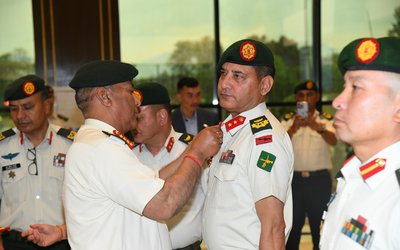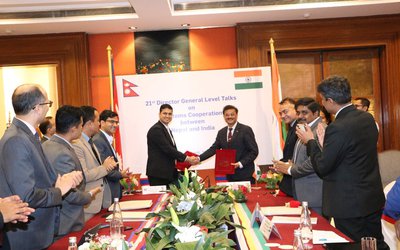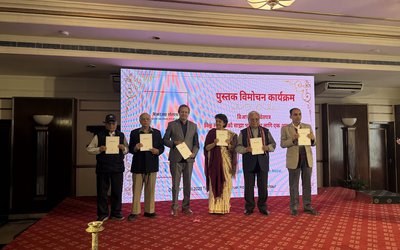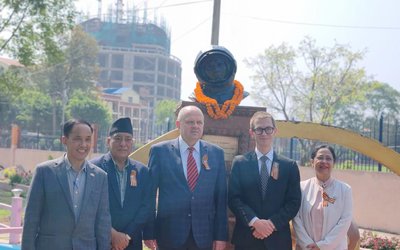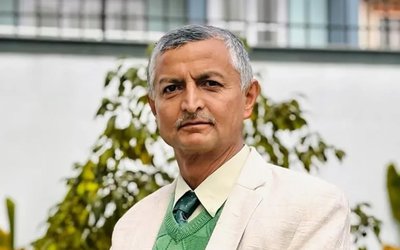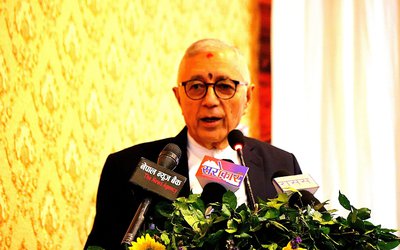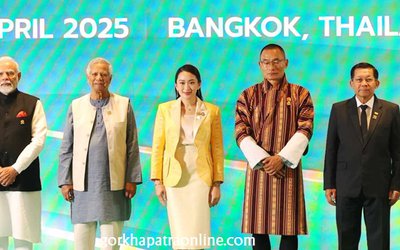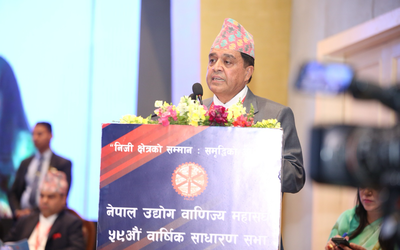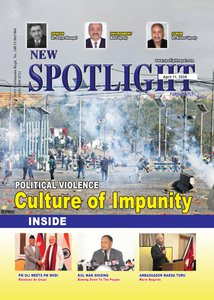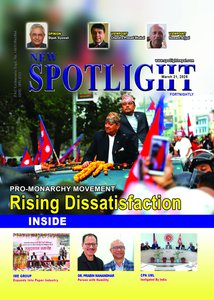
The blame game between the pro-monarchist and the forces of the current political establishment, both in power and in opposition, is dominating political discussions following a violent incident at a rally of pro-monarchist group in Tinkune, Kathmandu. Despite Nepal's 75-year political transformation from autocratic Rana Rule to the current republican, federal, secular, and inclusive system, there has been little progress towards a peaceful political culture. The Tinkune violence serves as a stark reminder of the challenges facing Nepal's political future.
The 2015 Constitution of Nepal glorifies all forms of political violence, granting impunity to those involved in political upheavals, making peaceful transitions unlikely in the near future.

By legitimizing political violence as a means for freedom and change, the constitution paves the way for more extreme actions in the future. The saying that the mother of extremism is violent extremism, with no limits, is becoming a reality in Nepal's political landscape.
In response to the demonstrators, including former King, Prime Minister KP Sharma Oli has announced that the government is considering establishing a legal commission or administrative committee to investigate the causes of the violence.
Nepal's political trajectory seems to be heading towards more extreme measures.
Prime Minister KP Sharma Oli has stated that there will be a fair investigation into the violence and use of force during the royalist protests, suggesting that a judicial inquiry may not be necessary. Mishra and Rana, senior leaders of the Rastriya Prajatnatra Party, have been detained in a manner deemed humiliating. Despite the arrest of over 30 individuals, including Rabiendra Mishra and Dhabal Sumsher Rana, on sedition charges, the prime minister has hinted at forming a commission to examine the violent incident that resulted in three deaths, including that of a journalist, and the destruction of public and private property.
Pressure for an Inquiry Commission
Initially, human rights activists, media outlets, and ruling parties, including the main opposition, strongly criticized and accused the pro-monarchist party of orchestrating the violent chaos. However, with numerous video recordings shared on social media depicting police brutality, the blame is now shifting towards the government and the Ministry of Home Affairs. Home Minister Ramesh Lekhak has consistently blamed the pro-monarchists while defending his ministry.
Lekhak stated, "The police showed great restraint during the violent demonstrations by the monarchists. It was not the security personnel but the monarchists who incited the violence. We will ensure that all perpetrators are held accountable for their actions."
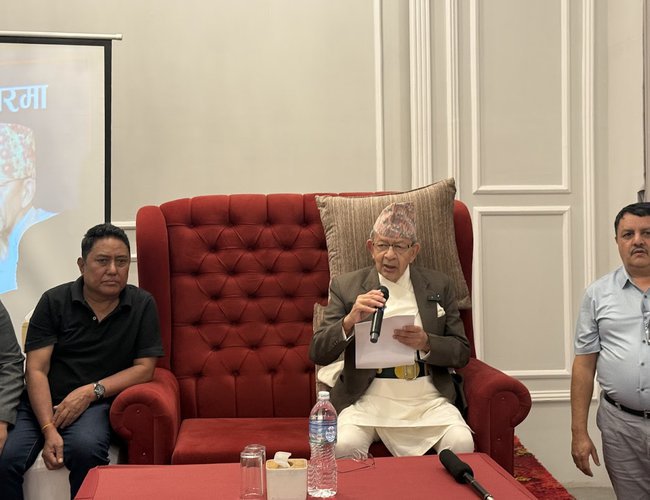
In contrast, RPP leaders have refuted these claims. Former president of the Rastriya Pajatantra Party (RPP), Pashupati Shamsher Rana, has demanded the immediate release of all political detainees, including Senior Vice President Rabindra Mishra and General Secretary Dr. Dhawal Shamsher Rana.
During a meeting with journalists, Rana expressed concern over the government's use of force against peaceful protesters during a recent event in Nepal. The protesters were demanding a constitutional monarchy, an eternal Hindu kingdom, the abolition of federalism, and an end to corruption and misrule. Rana criticized the government for arresting people without valid reasons.
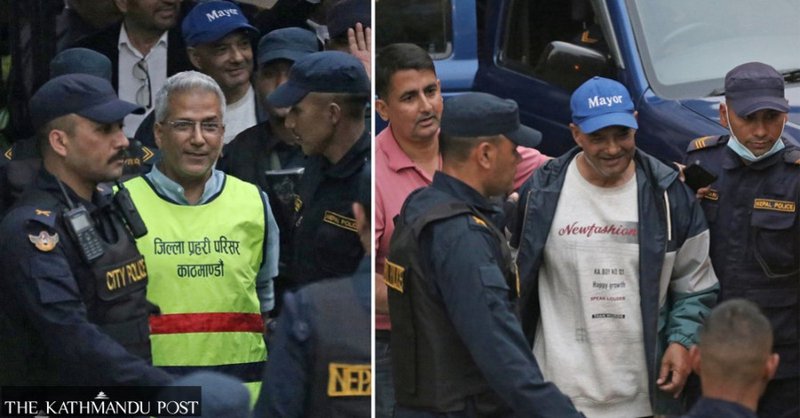
Human rights activists have also criticized the government for its treatment of RPP leaders, including Rabindra Mishra and Dhaval Shumsher Rana, who were reportedly held in police custody in a degrading manner. Charan Prasai, a former member of the National Human Rights Commission, highlighted the lack of democratic principles in the treatment of the detained leaders. He called for a fair and impartial investigation into the situation. The government is facing mounting pressure to establish an inquiry commission to investigate the violence that occurred on March 28. In Nepal, where political instability is a recurring issue, protests and demonstrations are common. The Local Administration Act, 2028 (1971) specifies the conditions under which the police can use force.
It is emphasized that in a situation where peace cannot be maintained and firing becomes necessary, the police should warn the crowd clearly by saying 'if you don’t move, we will fire' before taking action. Even in the event of firing, the directive specifies that shots should be aimed below the knee.
However, during a curfew, the Chief District Officer has the authority to instruct the police to open fire on individuals or groups violating the curfew to restore order.
Former security officials are advocating for an impartial and neutral investigation into the violence that occurred during the pro-monarchist demonstration on March 28.
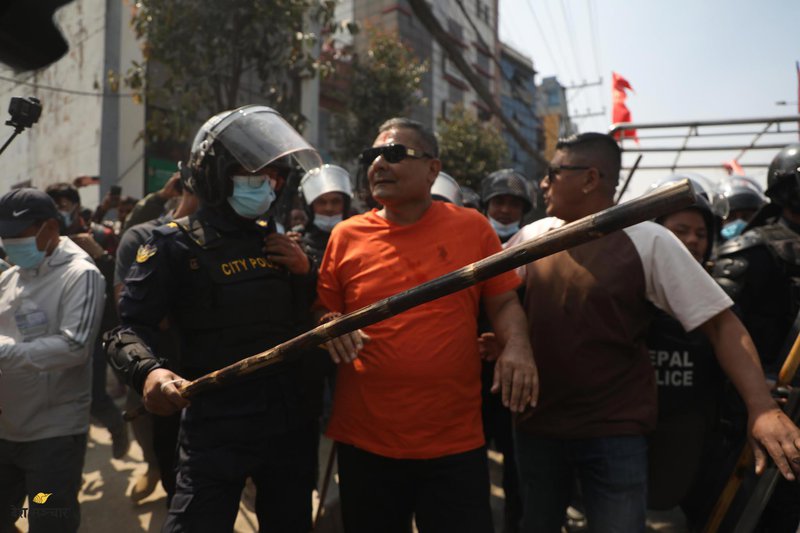
Former General of Nepal Army, Sudarshan Silwal, stresses the importance of the state preparing comprehensive plans in advance for such demonstrations and ensuring that security agencies are adequately equipped with resources.
He points out that the dissemination of false and misleading information through social media has exacerbated the challenges, highlighting that traditional crowd management methods are no longer as effective.
Silwal emphasizes the need for security personnel to be provided with adequate resources, training, and motivation, which are currently lacking, especially considering the dangers they face when protesters resort to violence by throwing stones, bricks, rods, and even petrol bombs.
Former administrators also highlight the security forces' limited ability to control crowds effectively. Former Home Secretary Mainali emphasized the importance of providing security personnel with the necessary tools and resources to handle situations without resorting to extreme measures like opening fire. He stressed the need for political movements to be managed politically and for those in power to address these issues.
Home administration officials claim that they are gradually equipping security forces with resources and tools. They acknowledge the importance of working within resource constraints, renewing equipment, and adopting new technologies to enhance security measures.
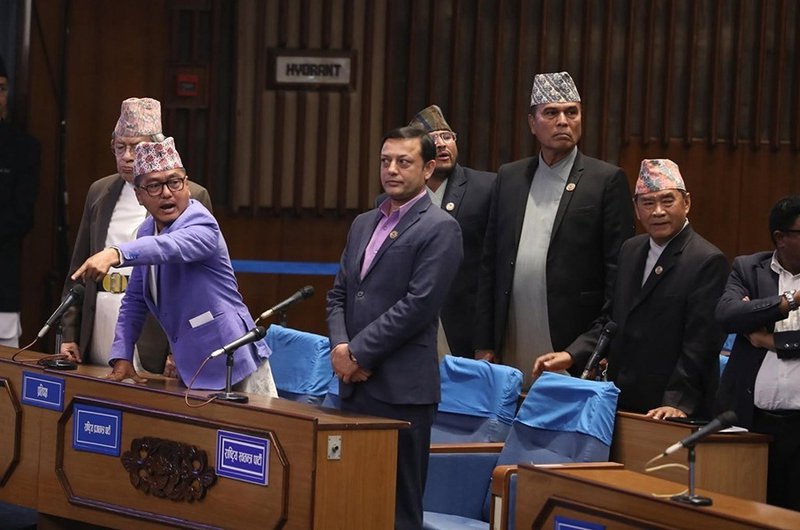
Former security officials have raised concerns about the violent and chaotic demonstration by supporters of the former king in Tinkune, Kathmandu on March 28, attributing the situation to weaknesses on both sides. They have called for an impartial investigation into the incident.
The government announced last week that the campaign led by Durga Prasai, which sparked the violent demonstration in the capital, would also hold the former king accountable.
Tinkune Incident
In a recent demonstration that turned violent, resulting in the deaths of two individuals, including a television journalist, over 100 people were injured, including security personnel. Approximately 20 individuals were struck by gunfire, with some claiming they were not even part of the protest. Several of the injured are in critical condition and are receiving treatment at various hospitals in the capital.
The protest also led to incidents of arson, vandalism, and looting in the vicinity, with media offices being targeted as well.
The Home Administration estimated that around 3,000 to 4,000 individuals participated in the protest, which escalated beyond expectations.

Law enforcement has apprehended over 50 individuals linked to the incident, with some facing investigations for charges of treason and organized crime. The police are actively seeking Durga Prasai, believed to be the protest's commander.
Former Home Secretary Mainali criticized the security forces for failing to adequately assess the potential risks of the protest location. He highlighted that the chosen site near the airport posed significant dangers due to crucial services, international flights, and flammable tankers in the vicinity. The protest's proximity to Tribhuvan International Airport led to the suspension of flight landings for nearly an hour and a half.
The government is addressing the aftermath of protests and ensuring accountability for violence. Protesters caused airport disruptions, leading to flight suspensions. Former officials question intelligence failure and security response. Impartial investigation needed. Former security officials suggest questioning roles of security forces and home administration. Deployment of 5,000 security personnel targeted both groups. Former AIG of Nepal Police raises concerns about managing the situation.
If the person leading the protest was known to potentially incite violence, the government should not have granted permission for the protest, or if it did, the protest should have been held in an open area. I believe the events were planned. An investigation should be conducted to identify those responsible, and the Nepal government and the Home Minister should take accountability for the situation.
"The events on Friday have raised numerous questions," he stated, emphasizing the need for an impartial investigation conducted by neutral parties, not affiliated with the Prime Minister.
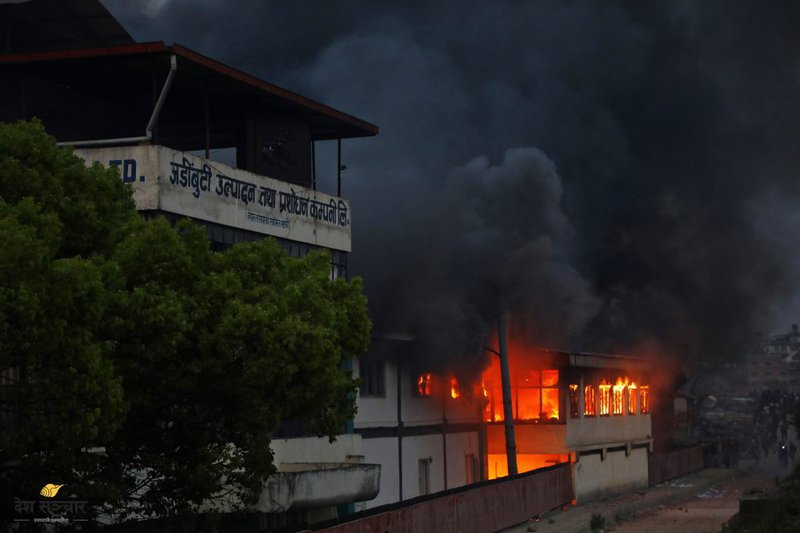
As incidents of looting and arson escalated in various areas, the authorities deployed the army on the streets on Friday.
Sudarshan Silwal, a retired Nepal Army Officer, pointed out the visible weaknesses on both sides. He suggested that security forces must analyze critical situations and develop a risk mitigation plan. The state should prepare a comprehensive plan in advance and ensure proper implementation to prevent such incidents.
While maintaining peace and order is the government's responsibility, he also stressed that those exercising their constitutional right to protest must take responsibility for their actions.
'Criminal Offense'
The Home Ministry spokesperson, Ramchandra Tiwari, stated that the incident on Friday is related to criminal offenses, and the police are currently investigating the matter. He emphasized that past protests have seen people throwing objects at government vehicles out of passion, and this incident is being treated as a criminal act.
Security officials are justifying their decision to permit the rally at Tinkune, stating that they did not expect it to turn violent. The police maintain that the organizers had no intention of holding a peaceful event and that protesters were incited to advance towards the Parliament Building. The police used tear gas, warning shots, and live bullets to control the situation, citing attempts to cause damage to sensitive structures and harm police officers.
Accountability Requested After Fatal Incident During the recent incident on Friday, Avenue TV cameraman Suresh Rajak tragically lost his life due to burns, and 29-year-old Sabin Maharjan from Kirtipur was fatally shot. As per the latest reports, nearly a dozen individuals are still undergoing treatment.
Calls for Accountability
Some security experts are questioning the use of lethal force by the state to quell the protest.
Former Additional Inspector General (AIG) of Nepal Police, Rajendra Bahadur Singh, has urged the government to investigate the circumstances leading to the police firing and provide a transparent response.
Reflecting on the 2006 People's Movement, Singh recalled, "During that period, we were instructed not to use force against protesters. We didn't even arm the police. Their role was to manage crowds and build trust with the people."
"Even when former Maoist rebels, who had been involved in internal killings during the armed conflict, joined the People’s Movement, the situation remained under control," he added.
"The current concerns being raised are troubling. The police must remain impartial. When the police are present, protesters should feel protected. We must operate within the boundaries of the law, acting as a bridge between both sides."
Security Options Limited in the Face of Violence and Chaos Former Home Secretary Mainali believes that the security forces had limited options in dealing with the violence and chaos during Friday's protest.
He stated, "Until the administration takes strict measures against violent mobs, peace and security cannot be maintained. Shooting at a crowd is risky and often leads to tragic outcomes."
The National Human Rights Commission reported that protesters breached the police barricade at Tinkune and clashed with security forces while attempting to enter the restricted area towards New Baneshwor. They threw stones at the police and engaged in stone-throwing and arson at private homes.
To control the crowd, the police used water cannons, fired warning shots, and deployed tear gas. The Human Rights Commission also noted that tear gas was used near private residences, with some videos on social media suggesting that tear gas was fired from the roof of one of these houses.
Former AIG of Nepal Police, Rajendra Bahadur Singh, believes that the protesters were provoked after tear gas was directed at their stage.
Mainali believed that in certain situations, tear gas might be necessary during crowd control, but he strongly opposed the use of a private house to launch tear gas. Former AIG Singh questioned the need to fire tear gas from a roof when the police had already bravely handled large protests. He emphasized that the police should only be on a roof to protect VIPs and not enter private homes.
Mainali also noted that the proper process of warning and communicating with the crowd through a microphone was not followed, which may have led to the escalation when tear gas and bullets were used.
During a press conference, the police spokesperson clarified that tear gas was not fired from civilian homes and that the tear gas used was not expired. The Ministry of Home Affairs has directed the police to investigate the matter with sensitivity in response to the concerns raised.
Durga Prasai, appointed as the 'Janacommander' by the United People’s Movement Committee, is currently wanted by the police, raising questions about his actions.
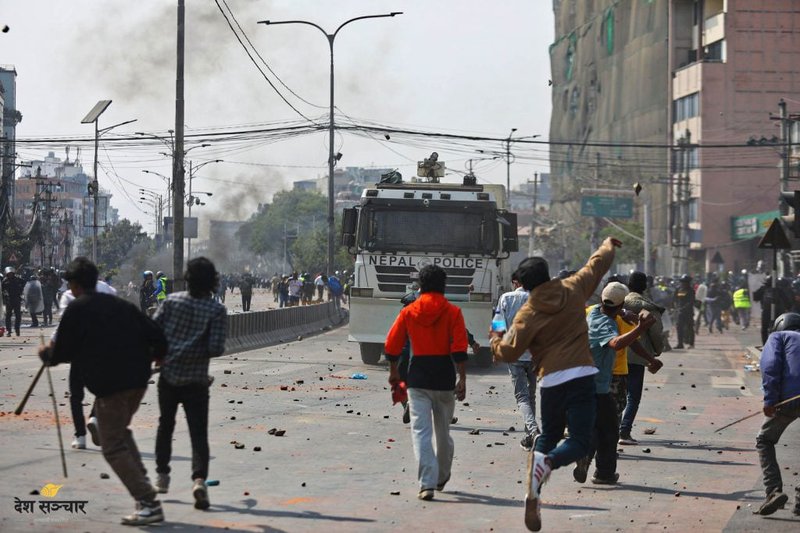
A video that went viral on social media shows a man driving into a restricted area and trying to break through police barriers after clashes had begun at Tinkune. Former Home Secretary Mainali expressed concern over the incident, stating that if the vehicle had posed a threat to the police, it could have led to a dangerous situation. Former AIG Singh also criticized the man's actions, suggesting that he should have been stopped from entering the restricted area. Police spokesperson Acharya confirmed that the man was arrested but could not be taken away due to the large crowd present.
Prasai, known for his controversial statements, transitioned from running a medical college to politics. He was once aligned with Maoist Chairman Prachanda and Prime Minister Oli but now advocates for the reinstatement of the monarchy and a Hindu nation.
His social media posts, which often target business figures and political leaders, have raised concerns about potential threats. Analysts criticize the security forces for not taking adequate measures in response to these perceived threats.
As long as the culture of political impunity continues to overshadow legitimacy and the rule of law, political violence cannot be prevented. It is essential for all political forces to uphold the principles of rule of law and justice.

Keshab Poudel
Poudel is the editor of New Spotlight Magazine.
- PM OLI MEETS PM MODI: No Progress
- Apr 09, 2025
- PM OLI’S THAILAND VISIT: Flip Flop
- Apr 08, 2025
- FM Dr. Deuba’s India Visit: Mission Aborted
- Mar 26, 2025
- AMBASSADOR MAEDA TORU: Warm Regards
- Mar 24, 2025
- PRO-MONARCHY MOVEMENT: Rising Dissatisfaction
- Mar 23, 2025
